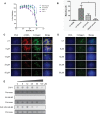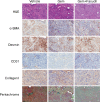Inhibition of ROCK1 kinase modulates both tumor cells and stromal fibroblasts in pancreatic cancer
- PMID: 28841710
- PMCID: PMC5571985
- DOI: 10.1371/journal.pone.0183871
Inhibition of ROCK1 kinase modulates both tumor cells and stromal fibroblasts in pancreatic cancer
Abstract
ROCK, or Rho-associated coiled coil-containing protein kinase, is a member of the AGC kinase family and has been shown to play a role in cell migration, ECM synthesis, stress-fiber assembly, and cell contraction. Increased ROCK expression has been reported in multiple pathological conditions, including cancer. Here, we report increased expression of ROCK 1 in pancreatic tumor epithelial cells as well as in cancer associated fibroblasts (CAF). In our analysis, 62% of tumor samples exhibited ≥2+ in staining intensity by IHC analysis, versus 40% of adjacent normal tissue samples (P<0.0001). Thus, we hypothesized that ROCKs may play a significant role in pancreatic cancer progression, and may serve as a suitable target for treatment. We report a low frequency (4/34) amplification of the ROCK1 gene locus at chromosome 18q11.1 in pancreatic ductal adenocarcinoma (PDAC) patient tissue samples by aCGH analysis. Inhibition of ROCK kinase activity by a small molecule inhibitor (fasudil) resulted in moderate (IC50s of 6-71 μM) inhibition of PDAC cell proliferation, migration, and activation of co-cultured stellate cells. In the KPC mouse model for pancreatic cancer, fasudil decreased tumor collagen deposition. This translated to an enhanced overall survival of the mice and an increase in gemcitabine uptake. Though fasudil may target both the tumor epithelial cells and the CAFs, our findings are consistent with the hypothesis that inhibition of tumor stroma enhances drug penetration and efficacy in PDAC. Overall, our data suggests that ROCK1 may serve as a potential therapeutic target to enhance current treatment regimens for pancreatic cancer.
Conflict of interest statement
Figures





Similar articles
-
Rho Kinase Inhibition by AT13148 Blocks Pancreatic Ductal Adenocarcinoma Invasion and Tumor Growth.Cancer Res. 2018 Jun 15;78(12):3321-3336. doi: 10.1158/0008-5472.CAN-17-1339. Epub 2018 Apr 18. Cancer Res. 2018. PMID: 29669760 Free PMC article.
-
Silencing PCBP2 normalizes desmoplastic stroma and improves the antitumor activity of chemotherapy in pancreatic cancer.Theranostics. 2021 Jan 1;11(5):2182-2200. doi: 10.7150/thno.53102. eCollection 2021. Theranostics. 2021. PMID: 33500719 Free PMC article.
-
Inter- and intra-tumoural heterogeneity in cancer-associated fibroblasts of human pancreatic ductal adenocarcinoma.J Pathol. 2019 May;248(1):51-65. doi: 10.1002/path.5224. Epub 2019 Feb 22. J Pathol. 2019. PMID: 30575030 Free PMC article.
-
Targeting ROCK activity to disrupt and prime pancreatic cancer for chemotherapy.Small GTPases. 2020 Jan;11(1):45-52. doi: 10.1080/21541248.2017.1345712. Epub 2017 Oct 3. Small GTPases. 2020. PMID: 28972449 Free PMC article. Review.
-
Should we keep rocking? Portraits from targeting Rho kinases in cancer.Pharmacol Res. 2020 Oct;160:105093. doi: 10.1016/j.phrs.2020.105093. Epub 2020 Jul 26. Pharmacol Res. 2020. PMID: 32726671 Review.
Cited by
-
Prenatal diagnosis and genetic counseling of a paternally inherited microduplication 18q11.1 to 18q11.2 in a chinese family.Mol Cytogenet. 2022 Sep 1;15(1):38. doi: 10.1186/s13039-022-00617-x. Mol Cytogenet. 2022. PMID: 36050713 Free PMC article.
-
Restriction of drug transport by the tumor environment.Histochem Cell Biol. 2018 Dec;150(6):631-648. doi: 10.1007/s00418-018-1744-z. Epub 2018 Oct 25. Histochem Cell Biol. 2018. PMID: 30361778 Review.
-
Mechanical forces in the tumor microenvironment: roles, pathways, and therapeutic approaches.J Transl Med. 2025 Mar 12;23(1):313. doi: 10.1186/s12967-025-06306-8. J Transl Med. 2025. PMID: 40075523 Free PMC article. Review.
-
Rho Kinase Inhibition by AT13148 Blocks Pancreatic Ductal Adenocarcinoma Invasion and Tumor Growth.Cancer Res. 2018 Jun 15;78(12):3321-3336. doi: 10.1158/0008-5472.CAN-17-1339. Epub 2018 Apr 18. Cancer Res. 2018. PMID: 29669760 Free PMC article.
-
The role of RAS oncogenes in controlling epithelial mechanics.Trends Cell Biol. 2023 Jan;33(1):60-69. doi: 10.1016/j.tcb.2022.09.002. Epub 2022 Sep 27. Trends Cell Biol. 2023. PMID: 36175301 Free PMC article. Review.
References
-
- Riento K, Ridley AJ. Rocks: multifunctional kinases in cell behaviour. Nat Rev Mol Cell Biol. 2003;4: 446–456. doi: 10.1038/nrm1128 - DOI - PubMed
-
- Schofield AV, Bernard O. Rho-associated coiled-coil kinase (ROCK) signaling and disease. Crit Rev Biochem Mol Biol. 2013;48: 301–316. doi: 10.3109/10409238.2013.786671 - DOI - PubMed
-
- Herpin A, Cunningham C. Cross-talk between the bone morphogenetic protein pathway and other major signaling pathways results in tightly regulated cell-specific outcomes. FEBS J. 2007;274: 2977–2985. doi: 10.1111/j.1742-4658.2007.05840.x - DOI - PubMed
-
- Papadimitriou E, Kardassis D, Moustakas A, Stournaras C. TGFβ-induced early activation of the small GTPase RhoA is Smad2/3-independent and involves Src and the guanine nucleotide exchange factor Vav2. Cell Physiol Biochem Int J Exp Cell Physiol Biochem Pharmacol. 2011;28: 229–238. doi: 10.1159/000331734 - DOI - PubMed
-
- Smith PC, Cáceres M, Martinez J. Induction of the myofibroblastic phenotype in human gingival fibroblasts by transforming growth factor-beta1: role of RhoA-ROCK and c-Jun N-terminal kinase signaling pathways. J Periodontal Res. 2006;41: 418–425. doi: 10.1111/j.1600-0765.2006.00886.x - DOI - PubMed
MeSH terms
Substances
Grants and funding
LinkOut - more resources
Full Text Sources
Other Literature Sources
Medical

